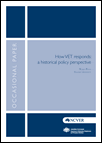Description
This document is an analysis of how policy has interacted with vocational education and training (VET) in Australia, with a particular focus on the period since the 1980s. It is accompanied by a timeline which sets out key policy documents that shaped the development of the VET system and by a list of Australian Prime Ministers and Labour Ministers (1940 to present), and Education Ministers and Industrial Relations Ministers (1960 to present).
Summary
About the research
This essay considers the evolution of the vocational education and training (VET) system since European settlement but focuses mainly on changes that have occurred over the last three decades. It discusses the underlying influences of key reforms, including the training reform agenda, which had as its main aim, the establishment of a national system. Also discussed are the programs and policy milestones that have shaped the VET landscape.
The essay drew on work that compiled major policy developments since the 1980s, now converted into a timeline identifying significant documents published since 1969 (with links to those reports available online). The timeline can be found at <http://www.ncver.edu.au/resources/timeline/overview.html>.
Key messages
- The VET system has generally been able to meet the training needs of the nation. Its deep-seated roots in Australian society have allowed it to continue, whatever the political climate, to serve both individuals and industry.
- VET has experienced periods of intense policy and product innovation, especially since 1975. However, not all reforms have managed to equally support the three main broad streams of VET: apprenticeship and traineeship training, general education and advanced education. The lesson here is that VET policy and innovation needs clear aims.
- The VET system has historically been neglected in favour of schools and university education but has shown remarkable resilience once resources and policy attention have been directed to it, especially considering how embedded it is in Australia's federal system.
Tom Karmel
Managing Director, NCVER
